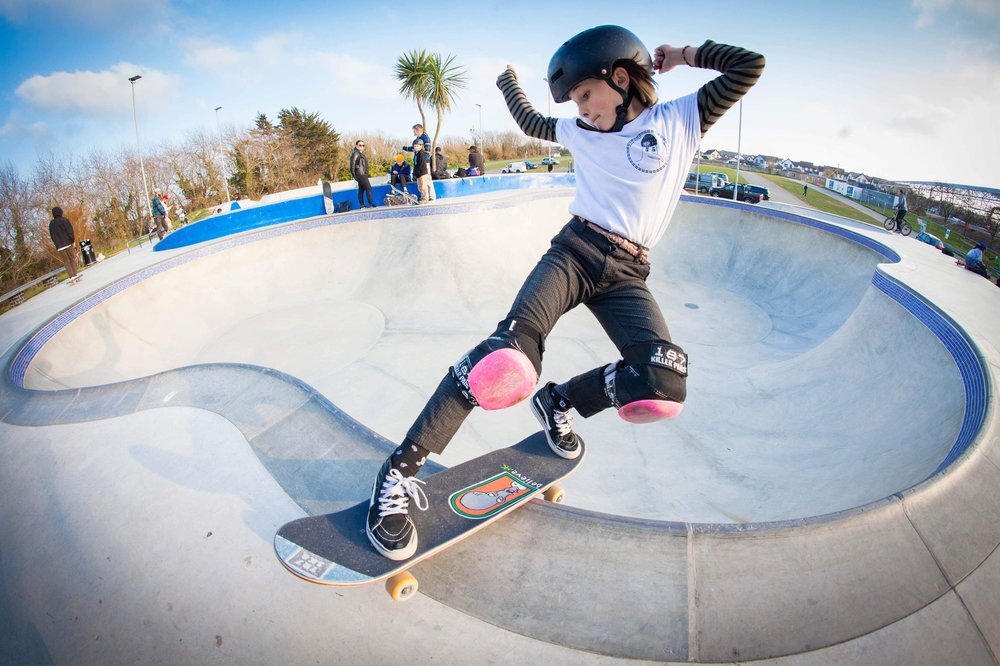Design and Development Guidance for Skateboarding
Concrete Waves Skateboard facility in Newquay.
Skateboard GB are delighted to launch the UK’s first official “Design and Development Guidance for Skateboarding” in partnership with Sport England. The guidance document aims to support the creation skateparks and skateboard facilities, through advice on design, construction and build. The guide provides information on the skateboarding environment, an overview of skateparks and skateable spaces, examples of skate parks and places to skateboard, procurement and supporting information on all aspects around planning for providing skateboard spaces in the UK.
A great planning document for Councils, Local Authorities, Community Groups, Charities and individuals planning to build a skatepark or skateboarding facility.
(1) Skateboarding Benefits
Skateboarding has been in the UK since the 1960's and today, it is widely practiced by 750,000 people across just about every village, town and city nationwide. Skateboarding continues to grow in participation by many of whom may not otherwise engage in sports activity. There are a number of reasons for this, including; affordability, accessibility, culture and it’s diversity.
With Tokyo Olympics set to showcase skateboarding for the first time, skateboarding is likely to become increasingly popular in the number and diversity of riders. This provides a new opportunity to release the activity’s untapped potential within our communities, Skateparks, alongside riding in public spaces and streets, which generate massive physical and mental health benefits, often among those who otherwise might not be active. These benefits range from introducing young children to sport as a playful activity, to engaging teenagers who might otherwise be un-attracted to team sports, through to maintaining consistent activity throughout peoples lives.
(2) Skateboarding and Skateparks
Most UK skateparks are situated outdoors and are constructed from a variety of materials including concrete, metal, composite and timber. Indoor skateparks tend to be constructed from timber. It is generally recommended that outdoor skateparks should be constructed in concrete because the material boasts a better and safer riding surface, significant durability with minimal maintenance, lower noise pollution and customisability of design. Skateparks typically incorporate one or more of the three main types of riding terrain: Street, Transition and Flow.
As their name suggests, skateparks are often focused at the needs of skateboarders. In fact, many skateparks are used by a variety of different wheeled devices, including: Skateboards, BMX, Other bicycles, WCMX (adapted wheelchairs), Scooters & Roller skates (traditional and in-line). Skateparks are not just sports facilities, but significant community spaces, and therefore often include a high quality of landscape design for their immediate setting and surroundings, in which the community can exist and develop.
(3) Skateparks: Sizes and Examples
Skateparks come in a wide range of sizes, designs and prevalence. Indeed, like golf courses, no two skatepark facilities are exactly alike, with each offering a near unique combination of challenges and opportunities for its riders. The size of skateparks varies hugely starting with a micro skate park, small, medium, large, national through to international standard.
Costs for skateparks vary greatly depending on size, ground conditions, materials and the riding features. As a ballpark figure, an outdoor concrete skatepark costs approximately £400 per m2 for its design and construction, with a micro skatepark costing from £40,000 - £50, 000 through to an international sized park costing anything upto £2 million.
(4) Skateparks: Procurement
There are various important stages and elements of the skatepark procurement process. Each project is, of course distinctly different and faces a diverse set of individual challenges, and most projects will not necessarily follow this route exactly.
Consultation: Commonly, there are a number of stakeholders in the process including: riders, local residents, council & community groups.
Location: Choosing the best location for a skatepark can often be one of the most challenging and important decisions in the process. Considerations need to be made for access, safety, surrounding landscape, noise, land ownership, services and conflict of activities.
Design: Quality of design is critically important to the success of a skatepark. The entire process relies on a design idea that brings to life all the hopes and dreams of the people involved. There are many fundamentals & design standards which need to be considered.
Planning Permission: The process is the most robust form of public consultation you can undertake. It enables you to build your skatepark in an agreed location, within a 3-year time frame.
Funding: There are a lot of potential sources for funding who will want to see that you are organised and have a worthwhile and realisable project to support.
Construction: Most construction works begin with written confirmation of a formal order. Once complete, a safety inspection needs to take place before the skate park can open.
(5) Good Examples and Case Studies
Skateparks play a fundamental role in providing accessible spaces for skateboarders to learn and develop skills, as well as valuable opportunities to exercise, socialise and be creative. To maximise the provision of skateboarding spaces and secure the maximum socio-economic benefits of skateboarding, it will be necessary to facilitate the provision not just skateparks, but also skateable public spaces in our towns and cities, by which we mean public spaces which positively welcome and cater for a diversity of uses and people, including skateboarding and skateboarders.
Good examples include:
UK - Hungerford Bridge in London, Riverside Museum in Glasgow & Buszy in Milton Keynes.
Europe - Rue Léon Cladel in Paris, Rådhusplassen in Oslo, Landhausplatz in Innsbruck & Tampere in Finland.
PDF Document with bookmarks, for navigation to chapters.
Please Contact Us if you require any further information.

